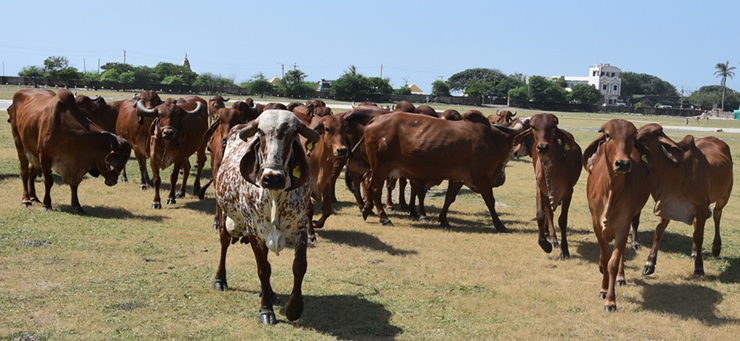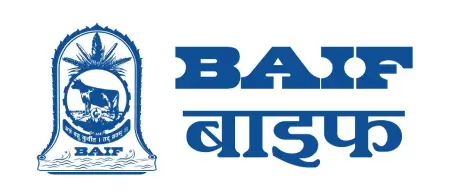
Amidst the scenic Gir forest dotting Saurashtra region of Gujarat, India, lies a treasure — the Gir cow. This local breed known for its unique qualities, plays a significant role in the farming system of this region. Join us as we dive into the world of the Gir cow, exploring its distinct features, historical significance and its role in sustaining livelihoods.
Intoduction:
The Gir cow hails from the Gir hills and the forested areas of Kathiawar and hence the name. Saurashtra region includes Junagadh, Bhavnagar, Rajkot and Amreli districts. The Gir cow is also known as Bhodali, Desan, Gujarati, Kathiawari, Sorthi and Surti across different sections of its breeding habitat.
Origin and Heritage:
The Gir cow, scientifically known as Bos indicus, finds its roots in the Gir forest of Gujarat. This historic breed has been a companion to farmers for centuries, playing a crucial role in the agricultural landscape of the region. Its adaptation to the hot and humid climate, marked by a distinct hump and pendulous ears, reflects the flexibility that has been improved over generations… Its presence in the agricultural practices of the region dates back to several centuries. The breed has played an essential role in sustaining communities, providing not only nourishment but also contributing to the economy through dairy.
Gir Communities:
Behind this iconic breed lies the dedicated communities of livestock keepers who have safeguarded the legacy of this breed for generations and which also reveals the rich cultural traditions and the importance of preserving and promoting sustainable practices for the well-being of the communities and the cherished Gir breed. These communities are Maldhari, Bhrawad (Gaderia), Rabari, Ahir, Jaat, Barda Dungar, Sumara, Sama – Muslim, Charan and Kathiawadi who have discovered their integrated connection with the valued Gir cow.

Breeding Practices:
Gir breeding practices are steeped in tradition, with focus on maintaining the purity of the breed. Gir breeders wisely select parent cows and bulls, considering their family and physical traits. This careful matchmaking ensures that the distinctive features of the Gir cow are passed on through generations.
Management practices:
The Gir cow, a symbol of India’s rich agricultural heritage, demands careful attention and thoughtful management to thrive in various environments. As keepers of this royal breed, farmers and caretakers play an essential role in ensuring the comfort and efficiency of Gir cows. In this note, we will explore key management practices that contribute to the health, comfort, and overall achievements of Gir cows. Management practises involve Quality Nutrition, comfortable Housing, Healthcare and Record keeping.

Gir Morphometric characteristics:
This indigenous breed has distinctive morphometric characteristics that contribute to its uniqueness including the features of the head, characteristics of the eyes, hump size, skin coat colour, skin types, body size, udder attributes, teat placement, horn characteristics, tail features and type of hump.
Milk Production:
A true leader in the dairy world, the Gir cow is famous for its high milk yield. The milk, rich in butterfat, forms the foundation for the production of ghee and other dairy products. This quality has elevated the breed to a major player in the dairy industry. Renowned for its adaptability, the Gir cow sparkles in tropical climates. Its ability to withstand heat stress and resist diseases makes it a valuable asset for farmers facing environmental challenges. Milk yield per lactation is a critical parameter in assessing the productivity of Gir cows. The average yield of 2110 kg reflects a moderate to high production capacity. The range from 800 to 3300 kg underscores the variability in individual cow performance, emphasizing the need for tailored nutrition and management practices to optimize milk production. Milk fat percentage is an important element of the quality of dairy products. The average fat content of 4.6% positions Gir cow milk favourably for the production of high-quality dairy products. The range from 3.9% to 5.1% indicates a steady and appealing fat, contributing to the nutritional value and market appeal of Gir cow milk.
Conservation Efforts of BAIF:
Recognizing the importance of preserving this genetic treasure, BAIF has made significant efforts to conserve and promote the Gir breed through Indigenous Breed Improvement Programme (IBIP) and Enhanced Genetics Project (EGP). Conservation initiatives aim to maintain the purity of the breed, ensuring its continued existence for future generations. On-going conservation efforts ensure that future generations can benefit from the invaluable genetic traits of the Gir breed, securing its place in the agricultural heritage of India.
In the agricultural scenario of the country, the Gir cow stands as a testament to the cooperative connection amongst humans and livestock. Its adaptive nature, rich history and immense contribution to dairy farming make it a breed worth cherishing. As we navigate the challenges of modern agriculture, the Gir cow serves as a reminder to the need to preserve our agricultural heritage and embrace sustainable practices for the future. The Gir breed has gained popularity not only in India but also in other parts of the world due to its desirable characteristics. It is important in the context of livestock diversity and contributes significantly to the agricultural economy, particularly in dairy farming.

The journey does not end here. There is a need to continue efforts in collecting various insights into Gir cow and thereby contributing to conservation initiatives for Gir breed for livestock management.
Stay tuned with us for more updates…

Ms. Tejashree Shirsath-Kalbhor
BAIF Development Research Foundation

Hi my loved one I wish to say that this post is amazing nice written and include approximately all vital infos Id like to peer more posts like this
Wow wonderful blog layout How long have you been blogging for you make blogging look easy The overall look of your site is great as well as the content
you are truly a just right webmaster The site loading speed is incredible It kind of feels that youre doing any distinctive trick In addition The contents are masterwork you have done a great activity in this matter
Asking questions are iin fact pleasant thing if you are noot understanding anything completely, however this post gives nce understanding yet. https://Odessaforum.Biz.ua/
Thank you I have just been searching for information approximately this topic for a while and yours is the best I have found out so far However what in regards to the bottom line Are you certain concerning the supply
Ive read several just right stuff here Certainly price bookmarking for revisiting I wonder how a lot effort you place to create this kind of great informative website